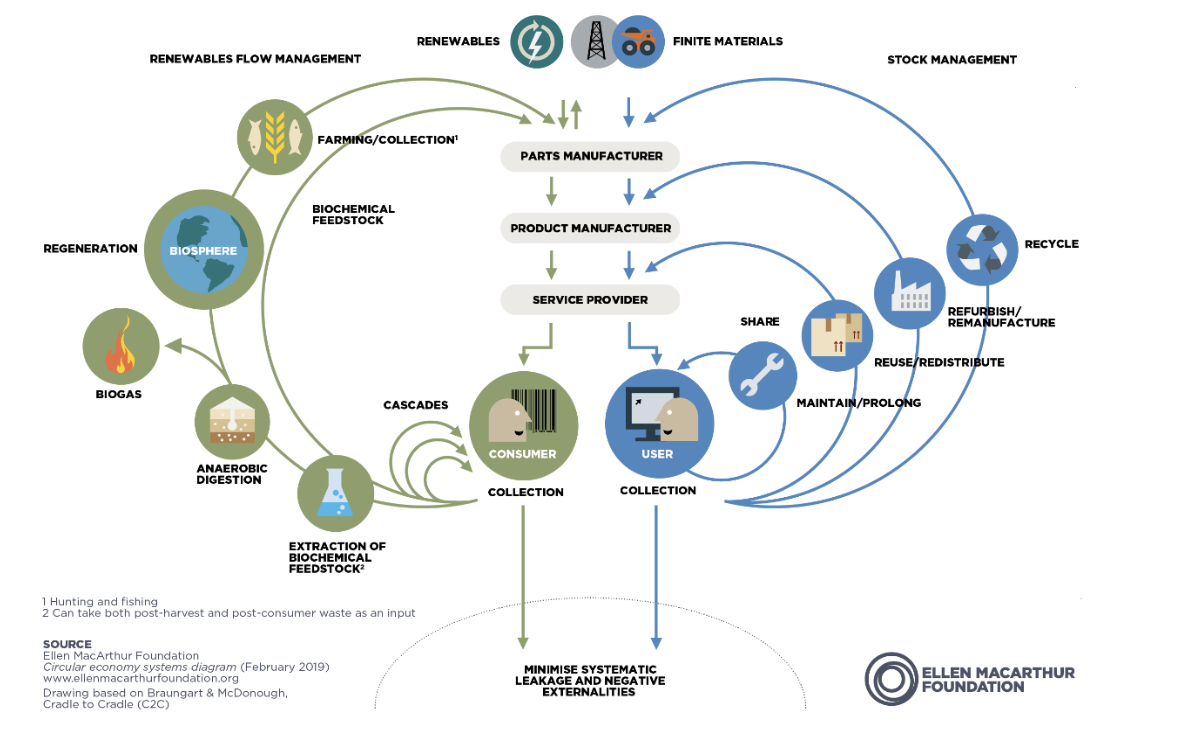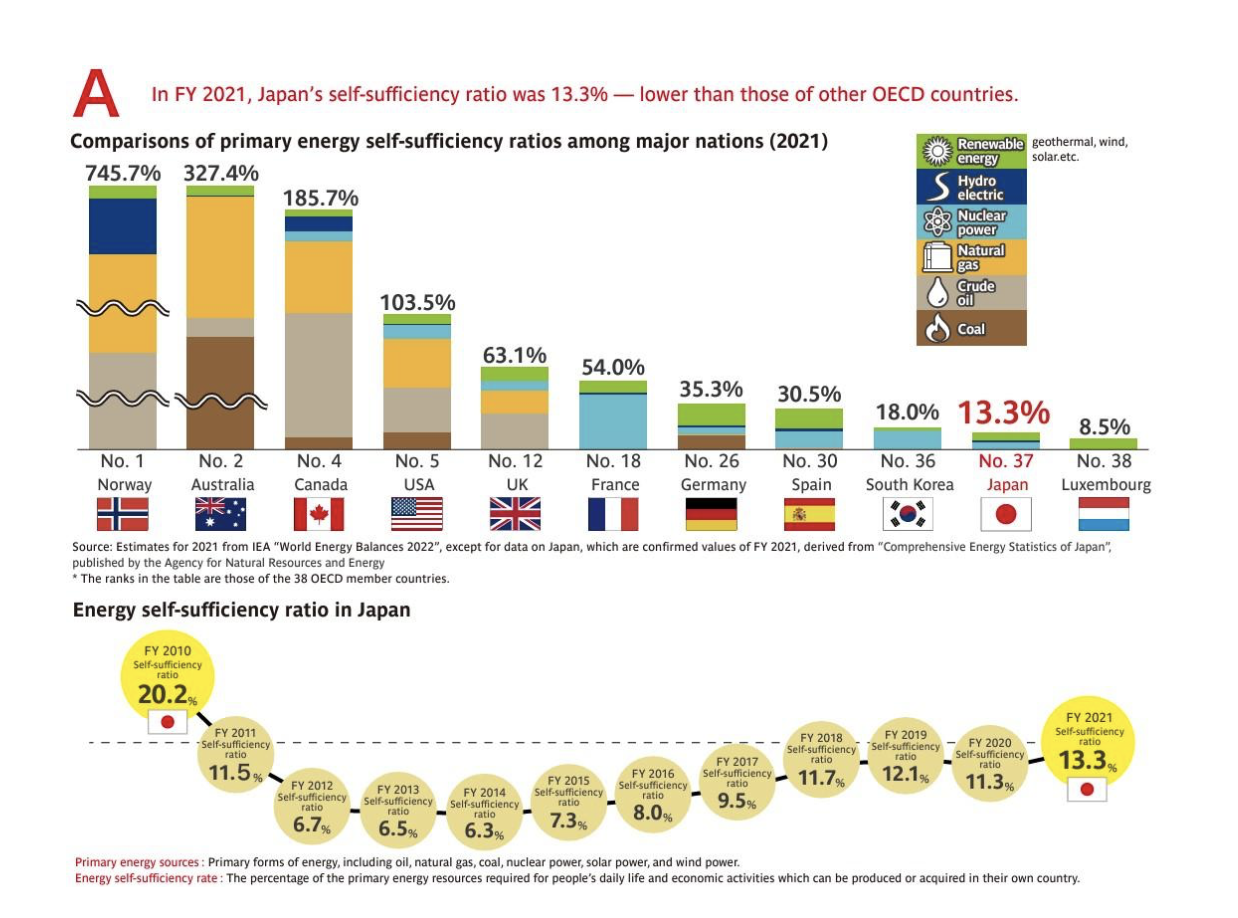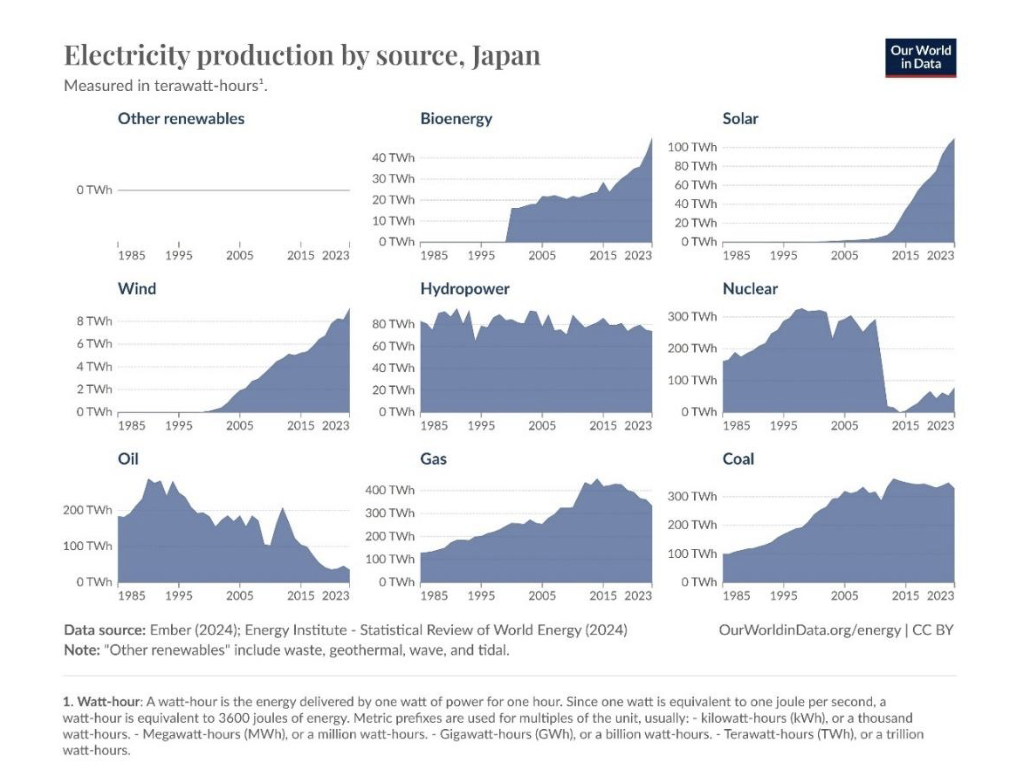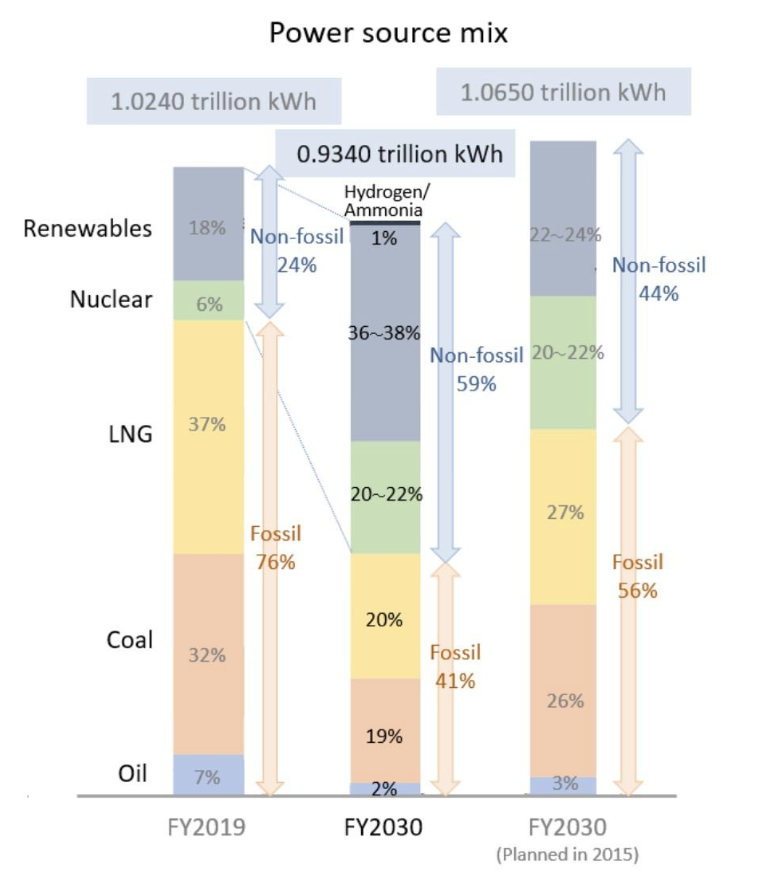Green vs pink hydrogen production in Japan: a partial circular economy approach (Part 1/6)


· 15 min read
This article is the first in a series of six, based on a research paper by Dr. Venera N. Anderson, “Comparative Analysis of Green and Pink Hydrogen Production in Japan Based on a Partial Circular Economy Approach”.
Japan is currently facing urgent energy and environmental challenges, demanding bold and sustainable solutions. As the world’s fifth-largest carbon emitter, the country must rapidly transition to cleaner energy sources to meet its 2050 carbon neutrality goal. Recognizing hydrogen’s potential, Japan has committed to major investments, including the $400 million Japan Hydrogen Fund and extensive government-backed incentives. However, while hydrogen is often seen as a “clean” energy source, its production and supply chains still carry emissions and environmental trade-offs. Identifying the most reasonable, practical, and economic source of clean hydrogen (green or pink) beyond 2040 is therefore critical. This research examines Japan’s energy and environmental situation, exploring how hydrogen, produced using a partial circular economy approach, could become the future cornerstone of Japan’s energy strategy.
Given Japan’s energy and environmental situations, this thesis seeks to explore the best reasonable, practical, and economic future (2040-beyond) source of clean hydrogen (green or pink) for Japan if produced based on a partial circular economy approach. It is vital to note that the so-called clean hydrogen (H2) is not entirely a clean energy source since all energy systems have pollutants, emissions, and other externalities in their lifecycles and along their supply chains (Sullivan, 2022c; Gencer, 2024). The thesis uses the term “clean hydrogen (H2)” since it is most frequently used in the global energy sector (Li et al., 2024, p. 1). The concept of a circular economy gained popularity recently, energizing environmentalists, businesses, and governments. Linear processes dominate the current industrial economy, working as an enormous network of conveyor belts where goods are made, sold, used, and discarded. Thus, a linear economic model has a one-way flow with a clear beginning and end. In contrast, a circular economy (CE) works differently (RTS, 2021), as shown in Figure 1.
CE is “an industrial system that is restorative and regenerative by intention and design” (RTS, 2021, p. 3). Ellen MacArthur Foundation (2024) describes the complete CE as one based on three principles, driven by its design to: 1) remove waste and pollution, 2) circulate materials and products (at their highest value), and 3) regenerate nature. The complete CE has two cycles, biological and technical, which address material production and consumption and the use of natural resources (Figure 1). The thesis adopts the partial CE approach (technical cycle) while exploring the best reasonable, practical, and economic future (2040-beyond) source of clean H2 (green or pink) for Japan.
Figure 1

The World Meteorological Report stated that 2023 was the hottest year in its 174-year climate record, with Antarctic Sea ice loss, sea level rise, ocean heat, and glacier retreat in Europe and Western North America (WMO, 2024). The findings of Working Group III of the IPCC (2022) Sixth Assessment Report warned that, based on current global targets expressed in National Determined Contributions (NDC), global temperature was likely to surpass 1.5°C of pre-industrial levels this century, based on current global targets expressed in National Determined Contributions (NDC). Even suppressing warming to below 2°C would rely on a rapid acceleration of mitigation efforts after 2030.
Clean H2 presents a significant opportunity for the global and Japanese energy sectors due to the current aspirations to confront climate change and boost energy security while leading toward more sustainable and cleaner energy sources (IEA; 2024, IRENA, 2024a). The enthusiasm surrounding clean H2 is not new. There were waves of H2 interest in the 1970s, the 1980s, and the early 2000s. The lack of success in the previous clean H2 scale-up was predicated by the dependence on high/rising gas and oil prices and the focus on one sector, transportation (IRENA, 2024a). In recent years, there has been hope that clean H2 time as a cleaner energy solution has finally come, although considerable financial and social complexities remain. However, the current wave of interest may finally be meant to stay. For instance, IRENA (2024a) states that “the global consensus now is that [H2] and its derivatives – produced in ways that yield low life-cycle greenhouse gas emissions (i.e. ‘clean [H2]’) – are part of the overall decarbonization transition” (p. 9), where low-carbon energy sources and carriers need to replace high-carbon ones to handle the rising energy demand (Corbeau et al., 2022). Moreover, in 2023, during the first Global Stocktake under the Paris Agreement (PA), the Conference of the Parties, for the first time, called upon the Parties to accelerate the adoption of “low-carbon hydrogen” (UNFCCC, 2023, p. 5; UNCC, 2024). Japan, the world’s fourth-largest developed economy and fifth-biggest carbon emitter, could spearhead implementing climate change countermeasures with transparency, ambition, and accountability while focusing on its energy and environmental situations (JT, 2024; UNCC, Statista, 2024a).
The global clean H2 industry is still nascent and is experiencing significant challenges as it scales up. However, much progress has been achieved in recent years since the number of committed projects that reached the final investment decision (FID) has risen from 102 ($10 billion in committed investment) in 2020 to 434 ($75 billion) in 2024. $680 billion in direct investments in clean H2 projects have been announced through 2030 (Hydrogen Council; Hydrogen Insights, 2024). The interest in clean H2 can be seen in Asia since Japan and South Korea have shown the highest relative growth in clean H2-related investments of nearly 130% from October 2023 to May 2024 as compared to India (110%) and the rest of Asia (75%) (Figure 2).
Figure 2

In September 2024, the Japan Hydrogen Fund, the first Japanese fund dedicated to developing low-carbon H2, with $400 million from various investors, was officially launched (Prevljack, 2024). Previously, Japan's government pledged to provide significant funding for the country's clean H2 ambitions. For instance, as of fiscal year 2020, government funding comprised support for clean energy vehicles ($247 million), FCV refueling stations ($120 million), the development of H2 supply chain abroad ($141 million), fuel cell R&D ($52.5 million), residential fuel cell and fuel cell innovators ($40 million), H2 supply infrastructure R&D ($30 million), H2 production/storage/usage technology development ($15 million). Japan's New Energy and Industrial Technology Development, also agreed to fund clean H2 projects to develop a clean H2 supply chain ($2.7 billion) and produce green H2 ($700 million). The funds originate from the $20 billion Green Innovation Fund, representing one of Japan's primary policy tools to support its 2050 carbon neutrality goal (Nakano, 2021).
Clean H2 Joint Undertaking (2024) affirms that as clean H2 matures as a valid market value proposition, it is necessary to focus on sustainability and environmental aspects while applying the CE approach in its development. The active research on the subject demonstrates the importance of this thesis’s research problem. The Circular Economy Handbook (Lacy et al., 2020) explained five CE business models that might offer a competitive advantage, such as 1) circular inputs, 2) product use extension, 3) resource recovery, 4) sharing platforms, and 5) product as a service. Nobre and Tavarez (2021) defined CE as “an economic system that targets zero waste and pollution throughout materials lifecycles, from environment extraction to industrial transformation, and final consumers, applying to all involved ecosystems…” (p. 10).
Sullivan (2022a) described CE as a “system within systems nested in systems and then linked to other systems and a recurring circle of resources and products. The circles need to be closed” (p. 2). Furthermore, Eh et al. (2022) focused on the challenges of a circular H2 economy, whereas Swisher et al. (2019) analyzed the economic viability of a sustainable H2 supply chain model by exploring how the current green H2 supply chain model could be adapted to Australia, given its energy and environmental situations. CE approach is especially necessary for island nations (Mohammadi et al, 2021; Andriamahefazafy & Failler, 2022). Moreover, the CE subject has been a priority for Japan, as described in its Circular Economy Vision 2020 (METI, 2020a). Arai et al. (2024) highlighted challenges in Japan’s CE discourses and implementation. Herrador et al. (2022) compared CE and net zero-carbon strategies between Japan and South Korea. Lastly, Han et al. (2023) investigated the development and utilization of clean H2 in the Japanese economy by 2050. Researchers performed simulations with the E3ME-FTT model and compared different policy scenarios and the economic and environmental impacts of the policy scenarios for clean H2 hydrogen development. Their results revealed that large-scale decarbonization via clean H2 development is possible (90% decrease in CO2 emissions in 2050 compared to the reference scenario) without the loss of economic activity.
The current research study is necessary since it seeks to build on the previous research and provide the answer to the following research question: given the country's energy and environmental situations, which type of clean hydrogen (green or pink) produced in Japan based on a partial circular economy approach would be a more reasonable, practical, and economic future (2040-beyond) energy source? This study is also timely since, in the spring of 2024, the Japanese government started to revise its Strategic Energy Plan (the 7th plan) and update the National Energy Outlook for 2040, which will inform how the country plans to meet its 2050 carbon neutrality pledge and describe its NDC for 2035 under the Paris Agreement (Nakano, 2024). Regarding mitigation, in the 2021 NDC, Japan committed to reducing its GHG emissions by 46% and potentially by 50% by the fiscal year 2030 against 2013 levels (UNFCCC, 2021). On November 25, 2024, Japanese policymakers released a proposal to lessen GHG emissions, compared to 2013 levels, 60% by 2035, 73% by 2040, and carbon neutrality by 2050. Unfortunately, Japan is not yet on the right course to meet these emission reduction targets or its 2050 neutrality goal (BloombergNEF, 2023; Japan Times, 2024).
The current NDC also stresses the significance of just energy transition policies by showing the country's commitment to creating new industries and jobs in the transition to a CE, which is vital for decarbonization, besides other goals (UNFCCC, 2021). OXFAM (2023) defined a just energy transition as one that strives to equitably defund fossil fuels by shifting the costs of climate action into wealthier polluters while focusing on economic, gender, and racial justice. Japan partnered with the World Economic Forum to promote CE approaches and enacted the Plastic Resource Circulation Act (April 2022). Other recent Japanese CE initiatives include recycling of solar panels, digital waste, and clothing (Zenbird, 2024).
Japan must consider various energy and environmental security, resilience, and reliability situations. First, energy security is a top priority for Japan's energy policy, defense, and national security strategies (JMD,2024; CS, 2022; METI, 2021a). Energy security is generally described as "the uninterrupted availability of energy sources at an affordable price" (IEA 2023b, para 1), although the issue is more complex. For example, energy security can be harmed due to using energy as a weapon and political instability in exporting and transit countries. For example, such issues can be seen during the Russia-Ukraine conflict (The Economist, 2022). Bazilian and Hendrix (2022) assert that Russia has a history of gas export manipulation for diplomatic purposes and the launch of military conflicts at the height of energy prices to exploit such vulnerabilities. Another way to harm energy security is through the "tyranny of small numbers and small spaces" (Sullivan, 2019, 2022b). For instance, Yokohama Bay, Houston Ship Channel, and Ras Tanura Oil Terminal-Main face the same predicament. The centralization and concentration of energy infrastructure and facilities may work during times of peace. However, such single facilities in small geographical areas are especially prone to risks due to terrorism, crime, and military conflicts (Sullivan, 2022b).
Japan's energy security environment is vulnerable compared to other OECD countries (METI, 2024), as shown in Figure 3. Historically, Japan's primary energy self-sufficiency ratio changed as follows: 6.5% (FY2013), 11.3% (FY2020), 13.3% (FY2021), and 12.6% (FY2022). The primary energy self-sufficiency ratio is defined as "total primary energy production divided by total primary energy supply" (IRENA, 2021, p. 3). In FY2010, the ratio was 20.2% before the Great East Japan Earthquake. Since then, the ratio has fallen substantially, primarily due to the shutdowns of the country's nuclear power plants (METI, 2022a). The Institute for Energy Economics, Japan (Eno et al., 2023) projects an increase of 2.1 points and 2.2 points for FY2023 and FY2024, respectively.
Figure 3

The fossil fuel dependency, the scarcity of domestic fossil fuels, and their imports from other countries largely explain the country’s low primary energy self-sufficiency ratio (METI, 2022a). However, methane hydrates, found below the deep-ocean floor off the coast of Japan, could meet the country’s natural gas demand (JOGMEC, 2024). Moreover, although Japan has other renewable energy resources, it does not use them to their full potential (geothermal, wind, solar, wave, and tidal). For example, in 2022, Japan, as the world’s fifth largest oil consumer, depended on imports for 97% of its primary energy supply. Since it had no international oil and gas pipelines, Japan relied on crude oil and liquefied natural gas (LNG) shipments to fulfill its energy demand. Although Japan is still highly dependent on fossil fuels, its consumption has declined. Nuclear and renewables have been the primary sources of replacing fossil fuels in the country’s generation mix (Figure 4).
Figure 4

METI (2022b) projects the following 2030 energy mix (Figure 5). In November 2024 the government announced its plans to keep the 20% share even in the 2040s (Nikkei, 2024). However, these ideas might not materialize due to the current political uncertainty described later in the study.
Figure 5

Furthermore, Japan’s electricity demand was projected to lessen due to energy efficiency improvements, a sizable decline in the population, and its aging population. However, due to the formulation of a new national strategy, GX 2040 Vision, Japan will face a major surge in domestic power demand due to establishing new data centers and new semiconductor plants. With the ongoing global race to capitalize on Artificial Intelligence (AI)’s economic and military potential, Japan especially needs to be a global leader in this new technology, described by the Google CEO Pichai as “more profound than electricity or fire” (Bordorff & Dunnmon, 2024, p. 1). Thus, Japan must ensure a sufficient and stable power supply as the country expands the capacity of decarbonized power sources (Shulman; Yuri Group, 2024; Shiraishi et al., 2023). At the same time, Japan’s energy transition must be orderly and just as possible, simultaneously accounting for the tradeoffs between its environmental and energy issues (Anderson, 2023).
Second, Japan’s energy resilience issues are also significant. Energy resilience is any energy system’s capacity for preparing, adapting, minimizing, avoiding, and recovering from predictable and sudden energy disturbances to ensure the system’s accessibility and dependability are sufficient for assurance and mission readiness (CLS, n.d.). The country’s energy resilience, worsened by natural disasters, happens due to the inadequately interconnected split electricity system, which comprises of two frequency areas (50 Hz and 60 Hz), ten regional grids, and a few but growing cross-border conversion interconnections (Nikkei, 2024). Lastly, Japan’s energy reliability deteriorated since earthquakes and typhoons led to large-scale and extended power outages (IEA, 2021). DOE (2023) describes energy reliability as “the ability of a power system to withstand instability, uncontrolled events, cascading failures, or unanticipated loss of system components” (p. 1). The recent Japanese legislation attempts to strengthen the country’s energy resilience and reliability by promoting the partnership plan’s stipulation for distribution and transmission operators for rapid disaster response and distributed grids. The effects of climate change and the continued integration of intermittent renewable energy may further influence Japan’s energy resilience and reliability (IEA, 2021).
The country could also consider its environmental security, resilience, and reliability situations. Environmental security is defined as a society or a nation’s ability to ensure asset scarcity (water, food, shelter), environmental risks, and other adverse changes (Goodman, 2012; Chalecki, 2002). Environmental resilience is an ecosystem’s agile ability for environmental recovery, reorganization, and damage resistance while transforming into a system with identical identity, feedback, function, and structure (CSU, 2023). Environmental reliability is its capacity to impact a country’s different situations in a disruptive or reliable manner, primarily through tsunamis, earthquakes, cyclones, and volcanic eruptions (Sullivan, 2023). Like the rest of the world, Japan deals with global climate change’s effects on its various environmental situations (JMA, 2023; Sekiyama, 2020). Water security is also a crucial issue since, between 2020 and 2030, a quarter of Japan’s population will live in water-scarce areas (WDL, 2024). These issues are critical in the energy transition, which strives towards carbon neutrality during macroeconomic impacts, the need for energy security, the global competition for critical minerals, and the North-South divide between developed and developing countries (Yergin, 2022). Notwithstanding its unique constraints, Birol (2021) believes Japan can still handle its energy and environmental challenges by building on its technological innovations and favorable financial conditions.
Japan is a unique island nation with a remarkable track record of confronting and transcending adversity. Today, the country faces significant energy and environmental challenges, yet it also possesses the innovation, resilience, and ambition to rise to the occasion. By building a circular economy around hydrogen, Japan can ensure a sustainable and resilient energy future. Pink hydrogen, produced based on a partial circular economy approach, offers the most reasonable, practical, and economic clean hydrogen solution for Japan beyond 2040. While the clean hydrogen sector is still navigating its path, the future lies in focusing capital, talent, and time on practical, sustainable solutions that match Japan’s unique energy and environmental context. Japan’s hydrogen economy will thrive if it emphasizes precision over hype.
For further details, you can find the list of references and appendix here.
illuminem Voices is a democratic space presenting the thoughts and opinions of leading Sustainability & Energy writers, their opinions do not necessarily represent those of illuminem.
illuminem briefings

Hydrogen · Green Hydrogen
illuminem briefings

Green Hydrogen · Hydrogen
illuminem briefings

Green Hydrogen · Sustainable Business
South China Morning Post

Renewables Tech · Green Hydrogen
Forbes

Green Hydrogen · Ethical Governance
Energies Media

Green Hydrogen · Hydrogen